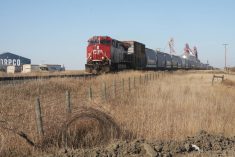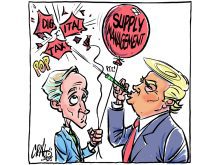Stories on Canada’s BSE crisis are rife with numbers and references to science and politics.
There is so much data, in fact, that readers might occasionally forget that this crisis has a human face. Many human faces, in fact, each with worry lines etched by the strain and uncertainty of the last 20 months.
Wilhelm and Cheri Vohs, Charolais breeders from Innisfail, Alta., were the human faces of the crisis last week. The couple, who have pride in their herd and confidence in their management, were nevertheless the owners of the latest cow to be diagnosed with BSE.
Read Also

Agriculture needs to prepare for government spending cuts
As government makes necessary cuts to spending, what can be reduced or restructured in the budgets for agriculture?
The Vohses have a herd of about 100 head, we learned last week, and they take care to register every purebred animal through the breed association.
Wilhelm started ranching with his father, Hans, in the early 1980s on a 960-acre ranch they dubbed Valley of Hope.
In 1998 he opted to try for extra gain on his calf crop through creep feeding. This one management decision, among the thousands he has made in a successful ranching career, is now thought to be at the root of the BSE case in his herd.
The second reported BSE case in nine days focused the media spotlight, and the Vohses stepped into it on Jan. 13.
About 60 members of the media congregated in the Innisfail Moose Hall to hear the Vohses explain the situation. They did so with dignity and candour, all the while clasping hands in mutual support.
They are good people in a bad spot, as were Trevor, Mel and Betty McCrea of Baldwinton, Sask., to whose herd the first BSE-positive cow was traced. And as were Wayne and Shirley Forsberg of Calmar, Alta., who once owned the cow that tested positive for BSE in Washington state in December 2003.
We’ve seen these people in the news and learned their stories. Their courage in explaining their circumstances has fostered greater understanding of the BSE crisis.
And for each of these seven people, there are thousands of other cattle producers suffering from this crisis.
These are the people poring over the farm accounts at the kitchen table or in the cranny of the house that has been set aside for the computer. They are the ones losing faith in their own valley of hope.
We do not know their stories. They do not want to speak of precarious finances or sleepless nights or the wistful way they look at their cattle herds, wondering what the next year will bring. And who, indeed, can blame them.
One cow and one nefarious, little-understood disease began this crisis. But it’s about far more than cattle today.

















